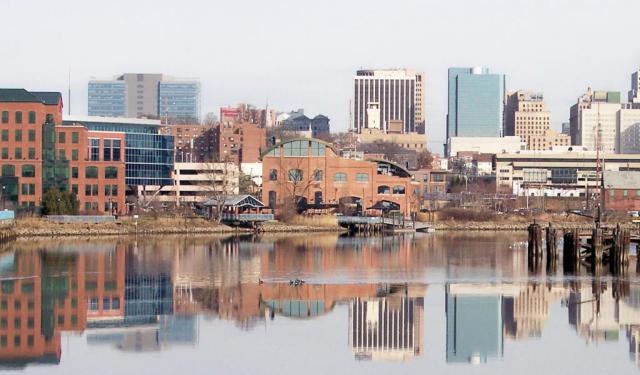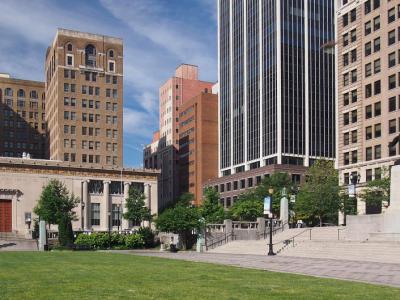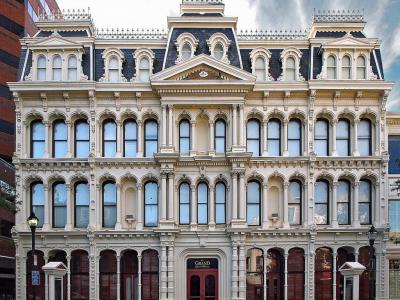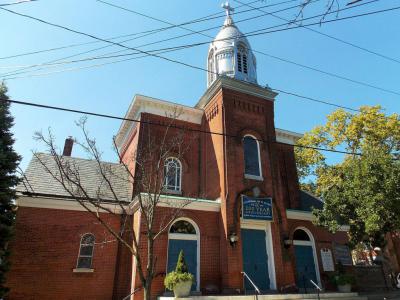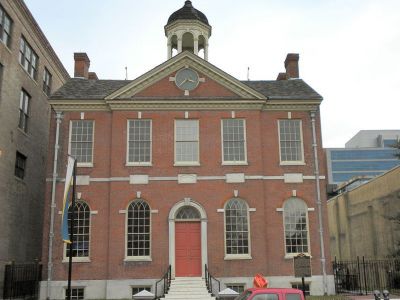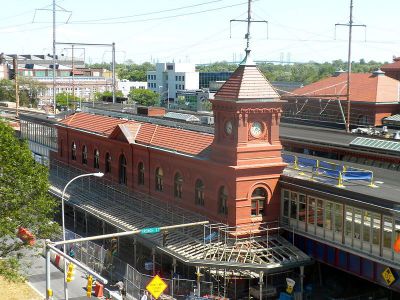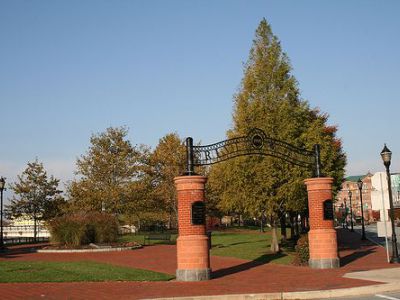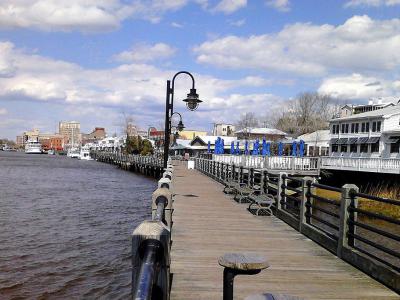Wilmington Introduction Walking Tour (Self Guided), Wilmington
Wilmington is the largest city in Delaware. It lies at the confluence of the Brandywine and Christina Rivers. Wilmington was originally home to the Lenape people. However, the land was purchased from Chief Mattahorn by the Swedish South Company in 1638. They built Fort Christina at the mouth of what would later be called the Christina River.
The Swedish lost control of the Fort Christina settlement when the Dutch took over. They called the area Willington after Thomas Willing, who developed the early city grid. It was the British who changed the city's name from Willington to Wilmington after they seized control. This change was in honor of Prime Minister Spencer Compton, Earl of Wilmington. The British remained in Wilmington through the Battle of Brandywine until 1778.
Wilmington continued to grow after the American Revolutionary War but the bulk of its growth happened during the US Civil War. The city became a center of industry building ships, manufacturing gunpowder and tanning leather. Wilmington's growth only expanded as times changed and manufacturing gave way to finance. Today the city is known as a national financial center for the credit card industry.
Visitors to the city spend a significant amount of time touring the historic buildings in the the town town area. Places like the Grand Opera House, St. Peter's Cathedral and the Old Town Hall show just how much the city has changed over the years. The Tubman-Garrett Riverfront Park displays the important role Wilmington held with the Underground Railroad. Likewise, the booming Wilmington Riverwalk is a cheerful and lively place for visitors of all ages.
Take this self-guided walking tour of Wilmington to see some of the most important places in this beautiful city.
The Swedish lost control of the Fort Christina settlement when the Dutch took over. They called the area Willington after Thomas Willing, who developed the early city grid. It was the British who changed the city's name from Willington to Wilmington after they seized control. This change was in honor of Prime Minister Spencer Compton, Earl of Wilmington. The British remained in Wilmington through the Battle of Brandywine until 1778.
Wilmington continued to grow after the American Revolutionary War but the bulk of its growth happened during the US Civil War. The city became a center of industry building ships, manufacturing gunpowder and tanning leather. Wilmington's growth only expanded as times changed and manufacturing gave way to finance. Today the city is known as a national financial center for the credit card industry.
Visitors to the city spend a significant amount of time touring the historic buildings in the the town town area. Places like the Grand Opera House, St. Peter's Cathedral and the Old Town Hall show just how much the city has changed over the years. The Tubman-Garrett Riverfront Park displays the important role Wilmington held with the Underground Railroad. Likewise, the booming Wilmington Riverwalk is a cheerful and lively place for visitors of all ages.
Take this self-guided walking tour of Wilmington to see some of the most important places in this beautiful city.
How it works: Download the app "GPSmyCity: Walks in 1K+ Cities" from Apple App Store or Google Play Store to your mobile phone or tablet. The app turns your mobile device into a personal tour guide and its built-in GPS navigation functions guide you from one tour stop to next. The app works offline, so no data plan is needed when traveling abroad.
Wilmington Introduction Walking Tour Map
Guide Name: Wilmington Introduction Walking Tour
Guide Location: USA » Wilmington (See other walking tours in Wilmington)
Guide Type: Self-guided Walking Tour (Sightseeing)
# of Attractions: 7
Tour Duration: 2 Hour(s)
Travel Distance: 2.8 Km or 1.7 Miles
Author: Sandra
Sight(s) Featured in This Guide:
Guide Location: USA » Wilmington (See other walking tours in Wilmington)
Guide Type: Self-guided Walking Tour (Sightseeing)
# of Attractions: 7
Tour Duration: 2 Hour(s)
Travel Distance: 2.8 Km or 1.7 Miles
Author: Sandra
Sight(s) Featured in This Guide:
- Rodney Square
- Grand Opera House
- St. Peter's Cathedral
- Old Town Hall
- Wilmington Train Station
- Tubman-Garrett Riverfront Park
- Wilmington Riverwalk
1) Rodney Square
Rodney Square is a historic square in downtown Wilmington. It was built in 1921 and completed in 1937. The square was designed in the Beaux-Art and Moderne styles. It was added to the National Register of Historic Places in 2011.
The square was named after Caesar Rodney, signer of the Declaration of Independence and the first President of Delaware. A large statue of Rodney atop a horse formerly stood in front of the square, but was removed in June 2020 due to his status as a slave owner. The statue was designed by James Edward Kelly in 1923.
After the removal of the statue, a large fountain was installed in the square. There are also plans for ongoing renovations. This is led by the Rodney Square Conservancy, the City of Wilmington and the State of Delaware.
Rodney Square is home to a number of outdoor meetings and festivals. Among these are the Clifford Brown Jazz Festival, a free jazz festival held each June. The Citizens Bank Caesar Rodney Half Marathon meets at the square each March. The city-wide New Year's Eve and Saint Patrick's Day celebrations also occur at Rodney Square.
The square was named after Caesar Rodney, signer of the Declaration of Independence and the first President of Delaware. A large statue of Rodney atop a horse formerly stood in front of the square, but was removed in June 2020 due to his status as a slave owner. The statue was designed by James Edward Kelly in 1923.
After the removal of the statue, a large fountain was installed in the square. There are also plans for ongoing renovations. This is led by the Rodney Square Conservancy, the City of Wilmington and the State of Delaware.
Rodney Square is home to a number of outdoor meetings and festivals. Among these are the Clifford Brown Jazz Festival, a free jazz festival held each June. The Citizens Bank Caesar Rodney Half Marathon meets at the square each March. The city-wide New Year's Eve and Saint Patrick's Day celebrations also occur at Rodney Square.
2) Grand Opera House (must see)
The Grand Opera House is a four-story theater built in 1871. It was designed by Thomas Dixon in the Second Empire architectural style for the Delaware Grand Lodge of Masons. Originally a theatre and Masonic Temple, the Grand Opera House famously uses Masonic imagery such as the Eye of Providence.
Patrons could see operas, symphonies, vaudeville acts and burlesque theatre through 1930. Warner Brothers ran the Grand Opera House as a movie theatre from 1930 through 1967. Once the movie theatre closed, it reopened to orchestral, opera and ballet performances.
Visitors to Wilmington can view a number of live performances at the Grand Opera House depending on when they are in the city. They can also take part in a group tour by calling ahead and making advanced arrangements. Most will simply enjoy a walking tour that allows them to admire the architecture of the building in a cozy, downtown environment.
The Grand Opera House was listed on the National Register of Historic Places in 1972.
Patrons could see operas, symphonies, vaudeville acts and burlesque theatre through 1930. Warner Brothers ran the Grand Opera House as a movie theatre from 1930 through 1967. Once the movie theatre closed, it reopened to orchestral, opera and ballet performances.
Visitors to Wilmington can view a number of live performances at the Grand Opera House depending on when they are in the city. They can also take part in a group tour by calling ahead and making advanced arrangements. Most will simply enjoy a walking tour that allows them to admire the architecture of the building in a cozy, downtown environment.
The Grand Opera House was listed on the National Register of Historic Places in 1972.
3) St. Peter's Cathedral
Saint Peter's Cathedral is a Roman Catholic cathedral in the Quaker Hill Historic District of Wilmington. The cathedral is the mother church of the Roman Catholic Diocese. It has held this distinction since the early 20th century.
The cathedral was designed by architect Pierre Bauduy in 1818. It was built in the Romanesque Revival architectural style. The church was extended and the bell tower added in 1829.
Much of the interior was added during a large remodeling project that was completed in 1905. The baptistry, altars and frescoes were added at that time. The stained glass, created by Franz Xavier Zettler, was added in 1900.
Saint Peter Cathedral school is located behind the cathedral. It was previously attached to the cathedral. But in 1905, when the apostolic pro-nuncio arrived after the church's remodeling project, he noticed that the church was joined to a rectory and a school. Since a cathedral must be free-standing and debt free, he refused to approve the church as a cathedral. Changes were made over the following years and the church was was eventually designated the cathedral of the diocese.
All visitors are invited to attend mass or schedule a tour of the building. Tours must be planned in advance by contacting the cathedral. Mass takes place Monday through Friday at 12:10 PM, Saturday at 4 PM and Sunday at 9:30 AM.
The cathedral was designed by architect Pierre Bauduy in 1818. It was built in the Romanesque Revival architectural style. The church was extended and the bell tower added in 1829.
Much of the interior was added during a large remodeling project that was completed in 1905. The baptistry, altars and frescoes were added at that time. The stained glass, created by Franz Xavier Zettler, was added in 1900.
Saint Peter Cathedral school is located behind the cathedral. It was previously attached to the cathedral. But in 1905, when the apostolic pro-nuncio arrived after the church's remodeling project, he noticed that the church was joined to a rectory and a school. Since a cathedral must be free-standing and debt free, he refused to approve the church as a cathedral. Changes were made over the following years and the church was was eventually designated the cathedral of the diocese.
All visitors are invited to attend mass or schedule a tour of the building. Tours must be planned in advance by contacting the cathedral. Mass takes place Monday through Friday at 12:10 PM, Saturday at 4 PM and Sunday at 9:30 AM.
4) Old Town Hall
Old Town Hall was built in 1798 as the center of the city's government. For almost a century, town meetings, elections and trials were held at the town hall. Likewise, the building was home to a library and jail cells. It held this role until 1916 when it was purchased by the Historical Society of Delaware.
Modeled after Philadelphia’s Congress Hall, the Old Town Hall is designed in the late-Georgian and early-Federal architectural styles. The brick building has a sloping roof with an octagonal cupola.
It originally held a bronze bell referred to as the Tatnall Bell. It was named after the Wilmington merchant who purchased the bell and the clock for the town hall. The bell was cast in England and worked with the clock to strike on the hour. It could not be rung manually to sound a fire alarm, call citizens to meetings, or perform special celebration or mourning. Today the Tatnall Bell can be found across the street from the Old Town Hall between the Simms House and the Library.
Those who wish to tour the building may take a self-guided tour from noon to 5 PM on Wednesdays through Sundays. These tours need to be scheduled in advance by contacting the historical society. The building was added to the National Register of Historic Places in 1974.
Modeled after Philadelphia’s Congress Hall, the Old Town Hall is designed in the late-Georgian and early-Federal architectural styles. The brick building has a sloping roof with an octagonal cupola.
It originally held a bronze bell referred to as the Tatnall Bell. It was named after the Wilmington merchant who purchased the bell and the clock for the town hall. The bell was cast in England and worked with the clock to strike on the hour. It could not be rung manually to sound a fire alarm, call citizens to meetings, or perform special celebration or mourning. Today the Tatnall Bell can be found across the street from the Old Town Hall between the Simms House and the Library.
Those who wish to tour the building may take a self-guided tour from noon to 5 PM on Wednesdays through Sundays. These tours need to be scheduled in advance by contacting the historical society. The building was added to the National Register of Historic Places in 1974.
5) Wilmington Train Station
The Wilmington Train Station is a busy train station that serves nine Amtrak routes, commuter trains and bus lines. The train station is familiarly known as Wilmington Station. It's official name is the Joseph R. Biden, Jr. Railroad Station. It was renamed after President Biden when he was serving as vice president in 2011.
The station was built in 1907. At that time, it was known as Pennsylvania Station due to the fact that it was owned by the Pennsylvania Railroad.
Architect Frank Furness designed the station so that trains moved through the second floor. He also included a four-face clock tower and decorative pieces made from stone and terra cotta. The station was designed in the Romanesque architectural style.
In 2009, the station underwent a massive remodeling project. Historic details were restored and the station was updated and made more accessible. It also has an inside level with stores, restrooms and a cafe.
The Wilmington Train Station was added to the National Register of Historic Places in 1976.
The station was built in 1907. At that time, it was known as Pennsylvania Station due to the fact that it was owned by the Pennsylvania Railroad.
Architect Frank Furness designed the station so that trains moved through the second floor. He also included a four-face clock tower and decorative pieces made from stone and terra cotta. The station was designed in the Romanesque architectural style.
In 2009, the station underwent a massive remodeling project. Historic details were restored and the station was updated and made more accessible. It also has an inside level with stores, restrooms and a cafe.
The Wilmington Train Station was added to the National Register of Historic Places in 1976.
6) Tubman-Garrett Riverfront Park
The Tubman-Garrett Riverfront Park is a 2.4-acre park that overlooks the Christina River. The park was named on behalf of Harriet Tubman and Thomas Garrett who were active in liberating slaves through the Underground Railroad.
The park is a popular spot for special events and city-wide celebrations. Visitors can find concerts, festivals, holiday celebrations and sporting events like the Delaware Marathon. Along with regular events, the park is home to a number of tranquil gardens and park benches. It is a quiet place that is ideal for taking a break from a busy day of sight-seeing.
The Tubman-Garrett Riverfront Park is an excellent place to learn about the history of the Underground Railroad. Plaques throughout the park explain the importance of the abolitionists and how both Tubman and Garrett were vital to the liberation of so many people. The park also has a large statue in honor of Harriet Tubman.
Unlike many parks, the Tubman-Garrett Riverfront Park is not open every day. The park is free and open to visitors 24 hours per day on Friday, Saturday and Sunday.
The park is a popular spot for special events and city-wide celebrations. Visitors can find concerts, festivals, holiday celebrations and sporting events like the Delaware Marathon. Along with regular events, the park is home to a number of tranquil gardens and park benches. It is a quiet place that is ideal for taking a break from a busy day of sight-seeing.
The Tubman-Garrett Riverfront Park is an excellent place to learn about the history of the Underground Railroad. Plaques throughout the park explain the importance of the abolitionists and how both Tubman and Garrett were vital to the liberation of so many people. The park also has a large statue in honor of Harriet Tubman.
Unlike many parks, the Tubman-Garrett Riverfront Park is not open every day. The park is free and open to visitors 24 hours per day on Friday, Saturday and Sunday.
7) Wilmington Riverwalk (must see)
The Wilmington Riverwalk is a 1.3-mile walking path along the Christina River. It begins at the Tubman-Garrett Riverfront Park and travels to the DuPont Environmental Education Center. There are many benches along the walk for those who need to take a rest. Tourists are also welcome to sit at the Hare Pavilion, which is located at the midpoint of the riverwalk.
The walk offers access to the Riverfront attractions. Some of these include the Frawley Stadium, a minigolf course, the Russell W. Peterson Wildlife Refuge, the Delaware Children's Museum, the Delaware Sports Museum and Hall of Fame and an IMAX theater. There are also numerous places to eat and shop.
Nature is abundant along the Riverwalk. Along with the aquatic wildlife from the Christina River, those walking on the path will see more than 5,000 trees and shrubs. They'll also view grasses, flowers and wetland plants.
The Wilmington Riverwalk is open daily from dawn to dusk.
The walk offers access to the Riverfront attractions. Some of these include the Frawley Stadium, a minigolf course, the Russell W. Peterson Wildlife Refuge, the Delaware Children's Museum, the Delaware Sports Museum and Hall of Fame and an IMAX theater. There are also numerous places to eat and shop.
Nature is abundant along the Riverwalk. Along with the aquatic wildlife from the Christina River, those walking on the path will see more than 5,000 trees and shrubs. They'll also view grasses, flowers and wetland plants.
The Wilmington Riverwalk is open daily from dawn to dusk.
Walking Tours in Wilmington, Delaware
Create Your Own Walk in Wilmington
Creating your own self-guided walk in Wilmington is easy and fun. Choose the city attractions that you want to see and a walk route map will be created just for you. You can even set your hotel as the start point of the walk.
Quaker Hill and Downtown Historical Buildings
For many visitors to Delaware's Wilmington, the downtown district is the main area of interest.
Indeed, the majority of Wilmington's most distinguished attractions are found here. Steeped in history, this part of the city still carries legacy of its first Swedish settlers much as that of the du Pont family who left a great deal of mark on the town's history. Some of the key local... view more
Tour Duration: 2 Hour(s)
Travel Distance: 2.8 Km or 1.7 Miles
Indeed, the majority of Wilmington's most distinguished attractions are found here. Steeped in history, this part of the city still carries legacy of its first Swedish settlers much as that of the du Pont family who left a great deal of mark on the town's history. Some of the key local... view more
Tour Duration: 2 Hour(s)
Travel Distance: 2.8 Km or 1.7 Miles
The Most Popular Cities
/ view all
